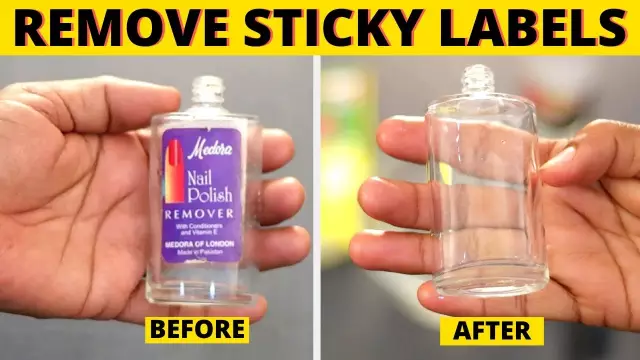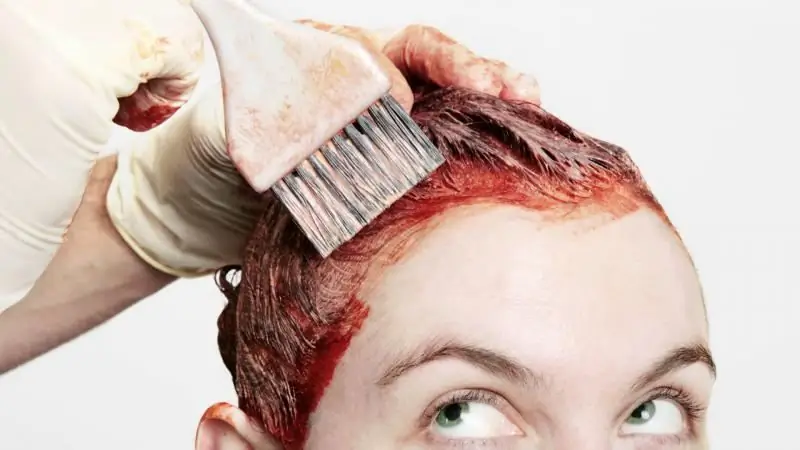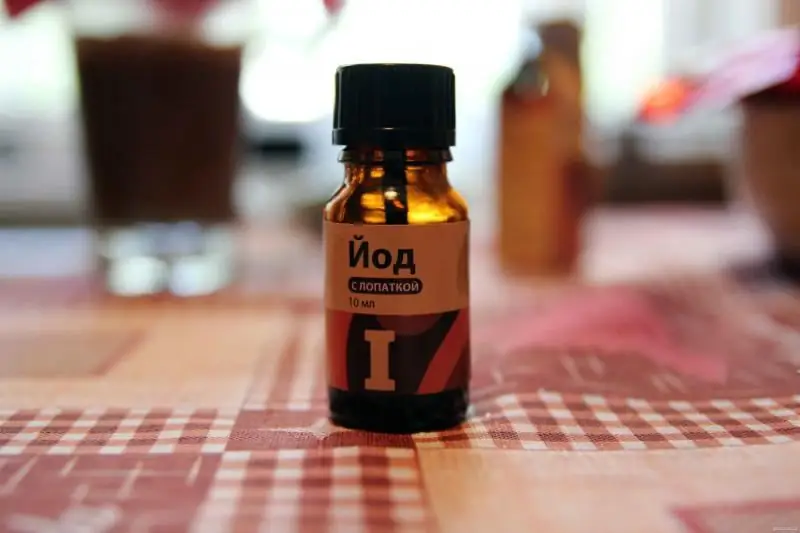
Table of contents:
- Author Bailey Albertson [email protected].
- Public 2023-12-17 12:53.
- Last modified 2025-01-23 12:41.
How to clean the resin at home and how to wash your hands from it

It is very easy to get stained with resin while walking in the forest, at a photo shoot or during repair work. It is much more difficult then to get rid of this substance on the skin of the hands, clothes, hair. There are ways to quickly wash out the resin.
Content
-
1 How to wash the resin off your hands
-
1.1 How to clean epoxy from hands and other skin areas
- 1.1.1 Baby Resin Cleansing Cream
- 1.1.2 Coca-Cola as a solvent
- 1.1.3 Soda
- 1.1.4 We clean the skin with rubber glue
- 1.1.5 A mixture of turpentine, starch and ammonia
- 1.1.6 Acetone
- 1.1.7 Video: acetone - epoxy solvent
-
1.2 How to wash the resin of pine and other conifers from your hands
- 1.2.1 Sunflower oil
- 1.2.2 How to wipe pine cone resin stains with rubbing alcohol
- 1.2.3 Citric acid from resin traces
-
-
2 Prohibited methods
- 2.1 Hot way
- 2.2 Cold cleaning method
- 2.3 Epoxy Solvents and Acid
-
3 How can you clean tar from your hair
3.1 Peanut butter and mayonnaise
- 4 How to wash the resin from the hair and skin of a child: useful tips
How to wash the resin off your hands
When traveling to pine forests, hunting mushrooms, or covering the roof, we may stain our hands and hair with wood or epoxy. They harden within 24 hours. Epoxy can glaze earlier (within 7-14 hours), depending on its composition. Drops of artificial and natural resins are removed in different ways, but it is worth using the described methods until the resin has completely hardened on the skin.

Wood resin is easier to clean than synthetic resin
How to clean epoxy from hands and other skin areas
Epoxy resin is a kind of durable adhesive. It adheres tightly to various materials: wood, roofing material, plastic. Epoxy is used for repairs in liquid form, after a while it hardens. It is necessary to immediately cleanse the skin from drops of resin, since with prolonged contact it causes irritation and swelling of the skin, serves as a source of allergies, redness and tearing of the eyes, irritation of the respiratory tract.
Baby resin cleansing cream
The most gentle way is baby cream. It not only removes impurities, but also softens the skin and reduces irritation. In addition, it rarely causes allergies and is suitable for both adults and children. It can be used on delicate and sensitive skin.
- Apply the product to the resin and skin around the stain.
- Wipe off immediately, then apply more cream and rub off again until the spots are completely clear. You can use a stiff brush for this.
- We wash off the remains with soap.

Baby cream safely removes epoxy
Coca-Cola as a solvent
Dissolves Coca-Cola resin well.
In fact, you can use not only Cola. Both Fanta and Sprite are often used as epoxy solvents.
-
For 1 liter of soda we take 1 tbsp. l. soda. Stir.

Coca Cola Soda water such as Coca-Cola can be used to clean the tar.
- We put our hands in the solution.
- We hold for 10 minutes.
-
We wash our hands with soap and cream.

Lubricate hands with cream After a soda bath, hands are washed and smeared with cream
Soda
Soda reacts chemically with the resin, softening it. There will be no harm from prolonged contact with soda. On the contrary, the substance relieves skin irritation and inflammation. The main thing is to prevent the gruel from drying out on your hands. It can be used on delicate areas of the skin, and will not harm children. We will need:
- water - 1 tbsp. l.;
- soda - 3 tsp.
Purification:
-
We make gruel from water and soda.

Soda and water are mixed with a toothbrush Soda is diluted with water to a slurry consistency
- Apply to the stained area of the skin and peel off the resin from the edges towards the center.
-
Wash off with warm water and soap.

wash your hands with soap After cleaning the resin with baking soda, wash your hands well with soap and water.
We clean the skin with rubber glue
Any rubber glue always contains a solvent. It acts on resin droplets on the skin. Do not use on baby skin: an allergic reaction may occur. It is important not to hold the glue for more than 10 seconds, otherwise you will have to remove it in addition to the resin.
- Apply some rubber glue to the stained area of the skin.
- We stand for 10 seconds.
- Roll up the resin with your fingers.
- Wash your hands thoroughly with soap.

The rubber glue contains a solvent that cleans epoxy well from the skin
A mixture of turpentine, starch and ammonia
To cleanse the skin, you should choose gum turpentine. Unlike the technical one, this product does not leave burns on the skin and does not cause allergies or dermatitis. Gum turpentine, being a highly purified substance, softens the resin to the required consistency. To get rid of epoxy, we need:
- ammonia - 3 drops;
- starch - 1 tbsp. l.;
- turpentine - 4 drops.
Purification:
- We mix the ingredients.
- Apply to the contaminated area of the skin.
- We scrub with a hand brush.
- We wash our hands.

Turpentine with the addition of ammonia and starch is also used to clean the hands of resin.
Acetone
Cleans the resin from the skin with acetone and products containing it, such as nail polish remover. It is not recommended to use acetone for colored clothes, as the color will be washed out with a solvent. In no case should you use this method for baby and delicate skin.
Operating procedure:
- Apply acetone or nail polish remover to a cotton pad.
- Apply to the resin for 3-5 seconds.
- We clean up the pollution.
- After applying acetone, we lubricate the skin with a moisturizer.

Acetone cleans epoxy well
Video: acetone - epoxy solvent
How to clean pine and other conifer resin from your hands
You can also use acetone or gasoline to clean your hands of tar. But you need to remember that in this case it is necessary to carry out the cleaning procedure in a well-ventilated area. In addition to solvents, folk methods are also used.
Sunflower oil
The method is absolutely safe for children and adults. Can be used for all skin types. Sunflower oil changes the consistency of the resin to a more liquid one, softens the substance. This makes the resin easier to remove from the skin.
- Apply sunflower oil generously to a cotton swab.
- Rub into the skin for 30-40 minutes, until the resin is cleaned.
- Wash off with hot water and soap.

Sunflower oil copes well with traces of wood tar
How to rub pine cone resin stains with rubbing alcohol
Alcohol is used for a wide variety of impurities, including against resin drops on the skin. Prolonged skin contact with alcohol is harmless. It does not threaten with chemical burns and wounds, on the contrary, it disinfects hands. The alcohol softens the resin to a sticky, viscous consistency, which removes tar droplets. The product can be used on adult and children's skin. Since alcohol dries slightly, evaporating from the surface, after using it, you can smear the skin with baby cream.
- We moisten a cotton pad in alcohol.
- Apply to resin for 20 minutes.
- We wipe the stain with cotton wool or gauze.

Alcohol easily removes tar from the skin
Citric acid from resin traces
Citric acid is used in everyday life as a mild chemical technical cleaner. It effectively dissolves resin due to its chemical composition. It is not recommended to use citric acid on delicate areas of the body and baby skin: it can lead to irritation.
- Take a soft sponge or cotton pad. Moisten with water.
- Sprinkle acid on the sponge and scrub the resin from the edges to the center of the stain.
- Wash off with warm water and soap.

Citric acid is able to remove tar stains
Prohibited methods
Some products cleanse the resin well, but have a negative effect on the skin. Their use is undesirable.
Hot way
It is effectively used for cleaning clothes, shoes, household items, but not for the skin of the hands or other parts of the body. The resin is ironed through the parchment with a hot iron. At high temperatures, the substance softens and can be removed with a sponge or cloth.
Cold cleaning method
It is also used only for household items. The thing stained with resin is frozen. The resin crystallizes on exposure to low temperatures. Then it is smashed with a hammer. You can, of course, try and thoroughly wipe the dirty place on your hand with a piece of ice for several minutes so that the resin hardens. But the required crystallized structure of matter cannot be achieved in this way. But getting a slight frostbite of the skin is as easy as shelling pears.

Using the cold method of cleaning the resin, you can get frostbite of the limbs.
Epoxy Solvents and Acid
Chemicals that are designed to cleanse epoxy - DMSO and DMF - can be purchased at any pharmacy. They are used to liquefy and dissolve resins. But none of these solvents can be used to cleanse the skin of the hands, face and other parts of the body from resin.
SP-6 wash is also the strongest solvent. It is designed to remove varnishes and paints from old ferrous metal, it also cleans epoxy resin. True, SP-6 is used in car services and at construction sites. After applying the remover, the paintwork swells, breaking down to a loose mass, which is then removed with a brush.
It is categorically impossible to use acid to cleanse parts of the body from resin. After all, sulfuric and tetrafluoroboric acids, when in contact with the skin, form an instant chemical burn. At the same time, coagulation necrosis is formed almost instantly - tissue necrosis. The skin instantly forms a white crust with well-defined borders. The stronger the acid concentration, the deeper the wound under the crust.

Skin contact with acid can have serious consequences
How can you clean tar from your hair
It is not just hands, feet or face that can get dirty in the resin. It is much more difficult for housewives when droplets of resin are frozen in chic long hair. We will not rush and take up the scissors. Let's try to fix the situation.
Peanut butter and mayonnaise
And again we turn to folk methods. Peanut butter or mayonnaise will help us. They soften the resin and strengthen the hair structure. For children, soap can be replaced with a special shampoo that, if it gets into the eyes, will not pinch too much. This method is great for both long and short hair.
- Apply mayonnaise or oil along the entire length of the soiled strand.
- We wrap the head with plastic wrap.
- We stand for 30 minutes.
-
Wash off with warm running water and baby soap.

Hair wash We wash hair after the procedure with warm water and soap
How to Wash Tar from Your Baby's Hair and Skin: Helpful Tips
- As we have already said, in no case should you clean the resin from children's skin with solvents, including acetone and gasoline. In addition to the fact that respiratory tract diseases can occur, there is a possibility of getting chemical burns and allergies.
- Do not use citric acid either. Although it is the mildest acid available, it can also damage the skin and cause irritation.
- Natural products are used for children: soda, sunflower, olive or peanut oil.
- It is important to ensure that when cleaning the products do not get into eyes, nose, ears, mouth. If the child swallows butter or a couple of grains of soda, there will be no harm. But, for example, a cream may well serve as a cause of gastrointestinal upset or poisoning.
- If molten hot resin comes into contact with the skin, a burn or open wound is formed underneath. It is washed with water. You do not need to cover it with adhesive plaster or wrap it with a bandage. It is important to keep the wound open and see a doctor right away.
- If, after cleaning the resin, the temperature rises, blisters have formed on the skin, you should also immediately go to the doctor.
We looked at various chemical and folk methods for cleaning resin from hands, hair and baby skin. They will help get rid of this sticky substance without harming your health and the health of your little ones.
Recommended:
How To Wipe Off The Glue From The Adhesive Tape - Remove Traces Of Ordinary, Double-sided, Painting From Plastic, Furniture, Glass, Clothes And Other Surfaces + Photos And Videos

Everyone uses scotch tape, and sometimes unpleasant traces remain after it. How to wipe off adhesive from plain or double-sided plastic, furniture, glass or clothing
How And How To Wash Polyurethane Foam From Hands, Face And Other Parts Of The Body, As Well As Remove It From Hair + Photos And Videos

Commonly used polyurethane foam is difficult to remove. How to wash it from hands, nails, face and body skin, as well as from hair?
How To Wash Fukortsin From The Skin, As Well As Wipe It Off Various Surfaces And Objects In The House

How and how to remove Fukortsin stains from various surfaces and human skin. Safe ways for children and sensitive skin. Proven recipes
How To Wipe Hair Dye From The Skin Of The Face, Hands, Nails Or Other Parts Of The Body + Photos And Videos

Effective ways to wipe hair dye stains from nails, face and hands. Handy tools, proven recipes, and unsafe but popular drugs
How To Remove Iodine From Clothes And Other Surfaces, Than To Wash It From The Skin, Various Methods And Means + Video And Photo

How to remove iodine from different fabrics, wash stains from furniture, body and other surfaces. Effective ways with instructions for use with photos and videos
